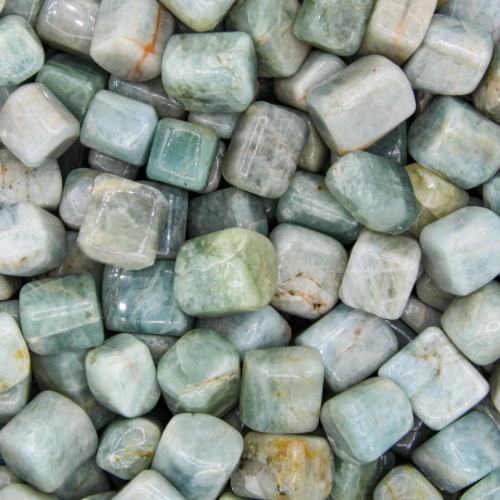Product Description
Quartz Green Tumbled Stone .75"-1"
Mineral Information:
Green quartz, also known as prasiolite or vermarine, is a variety of quartz that exhibits a green color. It is created through the heat treatment of amethyst or citrine, which transforms the color from purple or yellow to green. Here are some key features and characteristics of green quartz:
Color: Green quartz ranges in color from pale green to deep green, and its shades can vary from minty green to olive green. The color is typically uniform throughout the crystal, although variations may occur.
Transparency: Green quartz is usually transparent, allowing light to pass through the crystal. However, it can also occur in translucent forms, where light is partially transmitted but diffused.
Crystal Structure: Green quartz has the same crystal structure as other varieties of quartz, including clear quartz. It belongs to the trigonal crystal system and has a hexagonal prism shape with pointed terminations.
Luster: Green quartz has a vitreous luster, which gives it a glassy and reflective appearance.
Green quartz can be found in various locations worldwide, including Brazil, Madagascar, and the United States. Its vibrant green color and metaphysical associations make it a popular choice among crystal enthusiasts and collectors.
Metaphysical Meaning:
Green Quartz is said to help with emotional healing, such as healing emotional wounds and promoting peace and tranquility. It can also help reduce negative emotions and improve emotional resilience. Green Quartz is also used for spiritual growth and to improve prosperity and abundance. It is said that it helps open the third eye and crown chakras, which are connected to spiritual awareness and higher consciousness.
Mineral Care:
Green quartz, like other varieties of quartz, is relatively durable and has good overall toughness. However, there are a few considerations regarding the fragility of green quartz:
-
Hardness: Green quartz has a hardness of 7 on the Mohs scale, which means it is relatively hard and resistant to scratching. It can withstand everyday wear and tear and is less prone to surface damage compared to softer gemstones. However, it is still possible for green quartz to be scratched by harder materials, so it is advisable to avoid contact with materials such as diamonds or corundum.
-
Heat Sensitivity: While green quartz is generally stable under normal temperature conditions, extreme heat can potentially affect its color or cause thermal shock. Sudden temperature changes, such as placing green quartz in boiling water or exposing it to a direct flame, should be avoided to prevent any possible damage.
-
Chemical Sensitivity: Although quartz is relatively resistant to most chemicals, prolonged exposure to strong acids or alkalis can damage green quartz. It is advisable to avoid exposing it to household chemicals, such as bleach or hydrochloric acid, as they may etch or dull the surface of the stone.
-
Cleavage: Quartz has no true cleavage, meaning it does not break along specific planes like some minerals. Instead, it fractures conchoidally, producing curved and smooth surfaces. This fracture pattern generally makes green quartz less prone to cleavage-related breakage. However, it is still important to handle green quartz with care to avoid accidental drops or impacts that could cause fracturing or chipping.
While green quartz is considered relatively durable, it is still essential to handle it with care to prevent any accidental damage. Avoid exposing it to extreme temperatures, harsh chemicals, or rough handling that could lead to fractures or surface scratches. Regular cleaning and gentle storage in a safe place can help maintain the beauty and integrity of green quartz over time.
Disclaimer:
No information here is intended to diagnose, treat or cure ailments or afflictions of any kind. One should always consult a medical professional if a serious issue presents itself.








